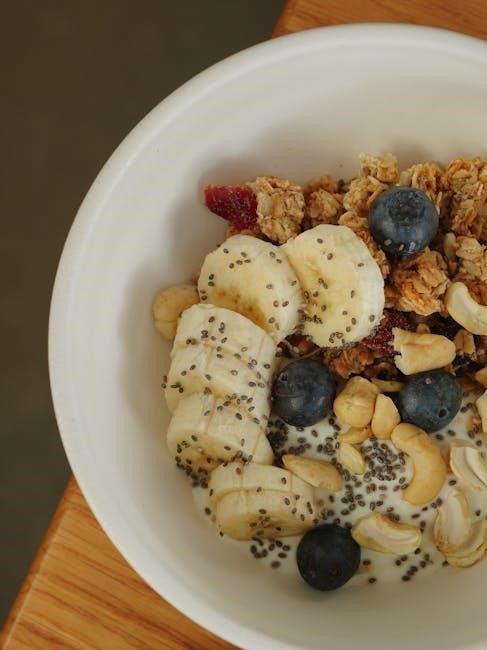A lactose-free diet helps manage lactose intolerance by eliminating lactose-containing foods. It emphasizes alternatives like dairy-free milk and lactose-free products, ensuring a balanced nutrition plan with the help of a comprehensive food list guide.
What is Lactose Intolerance?
Lactose intolerance is a condition where the body struggles to digest lactose, a sugar found in dairy products. It occurs due to low levels of lactase, the enzyme that breaks down lactose. Symptoms include bloating, gas, diarrhea, and stomach cramps after consuming lactose-containing foods. The severity varies; some people can tolerate small amounts, while others must avoid lactose entirely. It is not a milk allergy but a digestive issue. Managing lactose intolerance involves adopting a lactose-free diet, which excludes high-lactose foods like milk, cheese, and ice cream. However, many individuals can still consume lactose-free or low-lactose alternatives. A comprehensive lactose-free food list can help guide dietary choices, ensuring proper nutrition while avoiding discomfort. Early identification and dietary adjustments are key to managing this condition effectively and improving quality of life.
Why Choose Lactose-Free Foods?
Choosing lactose-free foods is essential for individuals with lactose intolerance to avoid discomfort like bloating, gas, and diarrhea. These products eliminate lactose, making digestion easier. With the growing demand, lactose-free options are now widely available, offering variety and convenience. They cater to diverse dietary needs, ensuring nutrient intake remains balanced. For instance, lactose-free milk provides calcium and vitamins without the digestive issues. Additionally, lactose-free diets are adaptable to various lifestyles, including vegetarian and vegan preferences. They also support long-term health by reducing reliance on potentially irritating foods. Overall, lactose-free foods are a practical and healthy choice for managing lactose intolerance while maintaining a nutritious and enjoyable diet.
Benefits of a Lactose-Free Diet
Adopting a lactose-free diet offers numerous benefits, particularly for those with lactose intolerance. It alleviates symptoms like bloating, gas, and diarrhea, improving overall digestive comfort. Lactose-free foods provide a wide range of options, including dairy alternatives and naturally lactose-free products, ensuring a varied and nutritious diet. These products are often fortified with essential nutrients like calcium and vitamins, maintaining dietary balance. A lactose-free diet also supports long-term gut health and reduces the risk of malnutrition from undigested lactose. Additionally, it encourages mindful eating and healthier food choices, promoting overall well-being. With the growing availability of lactose-free options, individuals can enjoy their favorite foods without compromising taste or nutrition, making it a sustainable and beneficial dietary choice for many.
Key Terms to Understand
Lactose intolerance: Inability to digest lactose. Lactose-free: Foods without lactose. Dairy-free: No dairy products. These terms guide dietary choices for managing lactose-related digestive issues effectively and nutritiously.
Lactose: What It Is and How It Affects the Body

Lactose is a sugar naturally present in milk and dairy products. It serves as a primary energy source for infants but can cause digestive issues in individuals with lactose intolerance. When consumed, lactose requires the enzyme lactase, produced in the small intestine, to break it down into easily absorbed sugars. In people with insufficient lactase, undigested lactose remains in the gut, leading to symptoms like bloating, gas, diarrhea, and abdominal pain. This discomfort can vary in severity depending on the amount of lactose consumed and individual tolerance levels. Understanding lactose’s role in the body helps individuals make informed dietary choices, whether opting for lactose-free alternatives or managing intake to avoid discomfort. Recognizing its effects is crucial for maintaining a balanced and comfortable diet.
Lactose-Free vs; Dairy-Free: What’s the Difference?
Lactose-free and dairy-free are often confused but serve distinct purposes. Lactose-free products remove or reduce lactose, a sugar in milk, through processes like enzymatic treatment, making them suitable for those with lactose intolerance. These products may still contain dairy proteins and fats. Dairy-free products, however, exclude all dairy ingredients, catering to individuals with milk allergies, vegans, or those avoiding dairy entirely. While lactose-free focuses on lactose removal, dairy-free eliminates all dairy-derived components. Understanding this distinction helps consumers choose products aligned with their dietary needs, whether managing lactose intolerance or avoiding dairy altogether. This clarity is essential for making informed decisions and ensuring a diet that meets specific health or lifestyle requirements.
How to Read Food Labels for Lactose Content

Reading food labels is crucial for managing lactose intake. Start by checking the ingredient list for lactose or dairy-derived ingredients like milk, whey, or lactose. Look for certifications such as “lactose-free” or “dairy-free” to ensure compliance with dietary needs. Be aware of hidden sources of lactose in processed foods, such as bread, cereals, or snacks. Pay attention to terms like “may contain milk,” which indicate potential cross-contamination. Additionally, review the nutrition facts panel for lactose content, though it may not always be listed. When in doubt, opt for products explicitly labeled as lactose-free or dairy-free. This careful approach helps maintain a lactose-free diet and avoids unintended exposure to lactose. Always verify the ingredient list to make informed choices aligned with your dietary requirements.

Popular Lactose-Free Food Categories
Lactose-free diets offer a variety of options, including plant-based milks like almond, soy, and rice milk, non-dairy creamers, and lactose-free dairy products. Meat, poultry, fish, and plant-based proteins are naturally lactose-free, providing versatile choices for meals and snacks.
Dairy Alternatives: Milk, Cheese, and Yogurt
Dairy alternatives provide excellent options for lactose-free diets. Plant-based milk varieties like almond, soy, and rice milk are naturally lactose-free and rich in nutrients. Lactose-free cheese and yogurt are also widely available, offering similar taste and texture to traditional dairy products without the lactose. These alternatives are perfect for those seeking to maintain calcium intake and enjoy dairy-like foods. Additionally, many brands now offer fortified versions, ensuring adequate nutrition. When choosing these products, always check labels to confirm they are lactose-free and low in added sugars. Incorporating these dairy alternatives into meals and snacks can make adhering to a lactose-free diet both enjoyable and sustainable.
Plant-Based Milk Options: Almond, Soy, and Rice Milk
Plant-based milk alternatives are a cornerstone of lactose-free diets, offering diverse and nutritious options. Almond milk is low in calories and rich in vitamins, making it ideal for those managing weight. Soy milk, with its high protein content, is a great dairy-free substitute for smoothies and cooking. Rice milk, lightweight and hypoallergenic, is perfect for sensitive digestive systems. These milks are naturally lactose-free and widely available in fortified versions, ensuring adequate calcium and vitamin D intake. Many brands also offer organic and unsweetened varieties, catering to specific dietary preferences. Whether for cereal, baking, or direct consumption, plant-based milks provide versatile and delicious alternatives to traditional dairy products, making them a staple in lactose-free households.
Lactose-Free Dairy Products: Availability and Benefits
Lactose-free dairy products are widely available and offer a convenient solution for those with lactose intolerance. These products, such as milk, cheese, and yogurt, have had lactose removed or have enzymes added to break down lactose, making them easily digestible. They retain the nutritional benefits of traditional dairy, including calcium, protein, and vitamins, making them an excellent choice for maintaining bone health and overall nutrition. Many brands now offer lactose-free options, ensuring accessibility in most supermarkets. Additionally, these products provide the same culinary versatility as regular dairy, allowing consumers to enjoy recipes without compromise. The growing demand for lactose-free dairy has led to innovations, such as lactose-free ice cream and cream, further expanding the range of available options. By choosing lactose-free dairy, individuals can enjoy the taste and benefits of dairy without discomfort, making it a practical and beneficial dietary choice.
Non-Dairy Creamers and Whipped Toppings
Non-dairy creamers and whipped toppings are excellent lactose-free alternatives for those seeking to avoid traditional dairy products. Made from ingredients like coconut oil, almond milk, or soy, these products mimic the texture and flavor of dairy-based options without the lactose. They are ideal for adding creaminess to coffee, desserts, or recipes. Many brands offer these products, ensuring a wide range of flavors and textures. Additionally, non-dairy whipped toppings are perfect for decorating cakes or topping hot chocolate, providing a guilt-free treat. These alternatives are not only lactose-free but also cater to vegan diets, making them a versatile choice for various dietary needs. With their ease of use and delicious taste, non-dairy creamers and whipped toppings are a popular choice for enhancing meals without the discomfort of lactose intolerance, ensuring everyone can enjoy their favorite treats comfortably.

Lactose-Free Food List: Detailed Options

A comprehensive guide to lactose-free foods includes milk, yogurt, cheese, and plant-based alternatives like almond, soy, and rice milk, ensuring a variety of nutritious and delicious options for all dietary needs.
Fruits and Vegetables: Naturally Lactose-Free Choices
Fruits and vegetables are excellent additions to a lactose-free diet, as they are naturally free from lactose. These foods provide essential vitamins, minerals, and fiber, promoting overall health. Popular options include berries, citrus fruits, apples, and bananas, while vegetables like leafy greens, broccoli, and carrots offer versatile and nutritious choices. Incorporating a variety of colorful fruits and vegetables ensures a balanced diet and supports digestive health. Many can be enjoyed raw, cooked, or blended into smoothies, making them convenient for meals and snacks. Additionally, they are rich in antioxidants, which help protect against chronic diseases. For those with lactose intolerance, fruits and vegetables are ideal substitutes for dairy-rich desserts or snacks. Always opt for fresh, organic choices when possible to maximize nutritional benefits and avoid hidden additives.
Proteins: Meat, Poultry, and Fish
Meat, poultry, and fish are excellent sources of protein in a lactose-free diet. These foods are naturally free from lactose, making them ideal for individuals with lactose intolerance. Options include chicken, turkey, beef, pork, lamb, and various fish like salmon, cod, and tilapia. These proteins are rich in essential nutrients such as iron, zinc, and omega-3 fatty acids. They can be prepared in numerous ways, including grilling, baking, or stir-frying, ensuring variety in meals. Additionally, they provide satiety and support muscle growth and repair. When choosing processed meats, it’s important to check for any added dairy products. Fresh, unprocessed options are the best choice to avoid hidden lactose. Incorporating a variety of these proteins into your diet helps maintain a balanced and nutritious lactose-free lifestyle, ensuring adequate nutrition without compromising on taste or convenience.
Grains: Bread, Pasta, and Rice
Grains such as bread, pasta, and rice are foundational components of a lactose-free diet. These foods are naturally free from lactose, making them ideal for individuals with lactose intolerance. Whole grains like brown rice, quinoa, oats, and barley are excellent choices, providing essential nutrients like fiber, vitamins, and minerals. Many types of bread and pasta are lactose-free, though it’s important to check labels for added dairy ingredients. Plain rice is also a versatile and lactose-free staple that pairs well with a variety of dishes. Grains can be easily incorporated into meals, offering both versatility and nutrition. They are also a great source of energy and can be paired with proteins, vegetables, or plant-based alternatives for a balanced diet. Ensuring a variety of grains in your diet helps maintain a nutritious and satisfying lactose-free lifestyle, while also supporting overall health and well-being.
Snacks: Lactose-Free Options for On-the-Go
Snacking on the go is easy with lactose-free options. Fresh fruits like apples, bananas, and berries are naturally free from lactose and packed with vitamins. Veggie sticks with dips like guacamole or hummus are both healthy and dairy-free. For a quick energy boost, consider nuts and seeds such as almonds, cashews, pumpkin seeds, and sunflower seeds. These are versatile and can be paired with dried fruits for added flavor. Granola and energy bars are also convenient, but ensure they are labeled as lactose-free. Dark chocolate, with at least 70% cocoa, is another delicious option, as it typically contains no dairy. Additionally, rice cakes, corn tortillas, and crackers made from plant-based ingredients are excellent choices for a quick snack. These options are not only lactose-free but also provide essential nutrients, making them perfect for maintaining a balanced diet while on the move.

Dietary Considerations and Tips
Always check food labels for hidden lactose. Maintain calcium intake through leafy greens and fortified products. Meal planning ensures variety and nutrition while avoiding dairy. Plan wisely and stay informed.
How to Maintain Calcium Intake on a Lactose-Free Diet
Maintaining calcium intake is crucial for bone health, especially on a lactose-free diet. Incorporate calcium-rich foods like leafy greens (kale, broccoli), fortified plant-based milks (almond, soy, rice milk), and lactose-free dairy products. Tofu, almonds, and calcium-set tofu are excellent sources. Fish with edible bones, such as sardines, also provide calcium. Check food labels for fortified cereals and juices. Consider supplements if dietary sources are insufficient. Meal planning should include a variety of these options to meet daily calcium needs. Consulting a dietitian can help ensure adequate intake. Always prioritize nutrient-dense foods to maintain overall health and bone strength while avoiding lactose.

Meal Planning: Incorporating Lactose-Free Foods
Meal planning on a lactose-free diet requires creativity and variety to ensure nutritional balance. Start by identifying lactose-free alternatives for breakfast, lunch, and dinner. For breakfast, opt for fortified plant-based milks like almond, soy, or rice milk paired with cereal or lactose-free yogurt. Incorporate lean proteins such as tofu or fish, and add lactose-free cheese for flavor. Lunch can include salads with lactose-free dressings or wraps using lactose-free cream cheese. Dinner ideas might feature lactose-free milk-based sauces or stir-fries with non-dairy ingredients. Snacks can include fruits, nuts, or lactose-free yogurt. Use a lactose-free food list to explore options and ensure meals are diverse. Consulting a dietitian can also help tailor meal plans to individual needs. With proper planning, a lactose-free diet can be both delicious and nutritious, ensuring all dietary requirements are met.
Hidden Sources of Lactose in Foods
Identifying hidden lactose sources is crucial for managing lactose intolerance. Many processed foods contain lactose, even if not obvious. Common culprits include bread, cereals, energy bars, and processed meats, which may use lactose as an additive. Additionally, some medications and vitamins include lactose as a filler. Always check ingredient labels for terms like milk, whey, or casein. Even foods labeled as “low-fat” or “reduced-fat” might still contain lactose. When dining out, be cautious of dishes with creamy sauces or dressings, as these often include dairy. Consulting a lactose-free food list can help avoid these hidden sources, ensuring meals remain lactose-free and symptom-free. Awareness and careful label reading are key to maintaining a successful lactose-free diet, especially when dealing with these unexpected sources.

Market Insights and Trends
The lactose-free food market is expanding rapidly, driven by growing health awareness and demand for dairy alternatives. It is projected to reach $36.68 billion by 2031, with a 11.7% CAGR.
Growth of the Lactose-Free Food Market
The lactose-free food market is experiencing significant growth, driven by increasing awareness of lactose intolerance and a rising demand for dairy-free products. According to recent reports, the global market size was valued at $18.73 billion in 2024 and is projected to reach $36.68 billion by 2031, growing at a compound annual growth rate (CAGR) of 11.7%. This expansion is fueled by advancements in food technology, such as precision fermentation, which enables the creation of lactose-free products that closely mimic traditional dairy. Additionally, the introduction of innovative products, like lactose-free chocolate ice cream made with precision fermentation, is attracting health-conscious consumers. The market is also benefiting from a growing preference for plant-based milk options, such as almond, soy, and rice milk, which are increasingly popular among those adopting lactose-free diets. As a result, the lactose-free food market is poised for continued rapid growth in the coming years.
Innovations in Lactose-Free Product Development
Innovations in lactose-free product development are revolutionizing the dairy-free market, offering consumers more diverse and nutritious options. One notable advancement is the use of precision fermentation technology, which allows for the creation of lactose-free dairy products that mimic the taste and texture of traditional milk. For instance, companies like Perfect Day are utilizing this technology to produce lactose-free ice cream with identical properties to conventional dairy products. Additionally, plant-based milks such as almond, soy, and rice milk are being further refined to enhance their nutritional profiles, often fortified with calcium and vitamins to match dairy’s benefits. These innovations are not only expanding the lactose-free food list but also making these products more accessible and appealing to a broader audience. As technology continues to evolve, the lactose-free market is expected to introduce even more creative and sustainable solutions, catering to the growing demand for dairy-free alternatives.
Adopting a lactose-free lifestyle is manageable with the right resources. Consult a detailed lactose-free food list PDF for guidance, ensuring a balanced and enjoyable diet tailored to your needs.

Final Thoughts on Adopting a Lactose-Free Lifestyle
Adopting a lactose-free lifestyle is a manageable and rewarding choice for those with intolerance. With the right resources, such as a comprehensive lactose-free food list PDF, individuals can navigate their dietary needs seamlessly. The variety of lactose-free products, including dairy alternatives and plant-based options, makes it easier than ever to maintain a balanced diet. By understanding food labels and exploring innovative products, individuals can enjoy their favorite foods without discomfort. The growing demand for lactose-free options has also led to market expansion, offering more convenient and nutritious choices. Transitioning to a lactose-free lifestyle is not just about restriction but about embracing a diverse and flavorful diet tailored to personal preferences. With the right guidance and resources, anyone can thrive on a lactose-free journey, ensuring their nutritional needs are met while enjoying delicious and varied meals.
Recommended Resources for Further Reading
For those exploring a lactose-free lifestyle, numerous resources are available to provide detailed guidance. A lactose-free food list PDF is an excellent starting point, offering a comprehensive guide to suitable foods and products. Additionally, websites like the National Institute of Diabetes and Digestive and Kidney Diseases offer insights into managing lactose intolerance; Books on dairy-free living and cookbooks focused on lactose-free recipes can also be invaluable. Many health organizations and dietitian-run blogs share tips and meal plans tailored to lactose-free diets. Furthermore, food manufacturers often provide lists of lactose-free products on their websites, making it easier to identify safe options. For those seeking personalized advice, consulting a registered dietitian or nutritionist can provide customized strategies for maintaining a balanced and enjoyable lactose-free diet. These resources collectively empower individuals to make informed choices and thrive on their dietary journey.